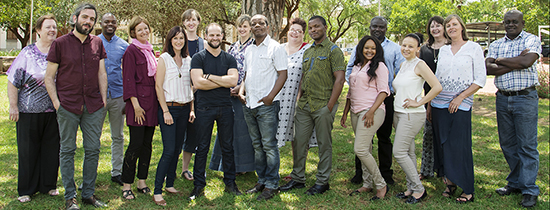
Lecturers from the Department of English at the University of the Free State have been working
hard to create a robust learning environment for students through continuous assessment.
Photo: Sonia Small
A new curriculum, exciting third-year seminars, and a transition to continuous assessment. These are some of the changes made by the Department of English at the University of the Free State (UFS) over the past few years. The department, which also boasts four National Research Foundation (NRF) researchers, did this to tailor the curriculum towards the needs of its students and to foster a better culture of engagement.
According to Prof Helene Strauss, Head of the Department, the advantages of these changes are clear. “Staff have noted a significant improvement in both the basic writing and critical deliberation skills of our students, and in the responsibility they are taking for their own learning.” The new curriculum empowers students to take a position in relation to the knowledge they encounter in the classroom, thereby strengthening their own critical voice.
Taking continuous responsibility
One of the most significant changes for students was the fact that they have to take responsibility all the time. Prof Strauss says continuous assessment changed “last-minute cramming to near-daily, student-centred activities of reading, writing, and critical discovery.”
Because students have to prepare for lectures and reflect on materials, they are in a better position to internalise difficult debates and critical concepts. “Rather than telling students what to think, we help them develop flexible, critical tools to make sense of a changing world.”
Third-year seminars are another way of including forms of instruction that concentrate on the links between education and democracy, but still improve students’ ability to speak and write English accurately. Every semester, students can choose seminars from a range of topics such as ‘Witchcraft’ (Prof Margaret Raftery) and ‘The Art of Dying’ (Dr Mariza Brooks).
Research and associates around the world
Dr Marthinus Conradie, Dr Rodwell Makombe, Prof Irikidzayi Manase, and Prof Strauss are all NRF-rated researchers in the department.
The department also has affiliated research associates from countries including Zimbabwe, the USA, and Canada. Dr Kudzayi Ngara currently holds a competitive NRF grant for a project on Southern African urbanity, and Dr Philip Aghoghovwia recently received the prestigious African Humanities Programme Fellowship.
Under the guidance of Dr Ngara, the department has been able to roll out a new Honours programme on the Qwaqwa Campus. The campus now also offers students the opportunity to pursue MA and PhD studies.
Other highlights:
• Hosted the international Institute of the Association for Cultural Studies in 2015.
• Books published: Dr Susan Brokensha (with Burgert Senekal). Surfers van die Tsunami: Navorsing en Inligtingstegnologie binne die Geesteswetenskappe (SUN MeDIA, 2014); Prof Iri Manase. White Narratives: The depiction of post-2000 land invasions in Zimbabwe (UNISA Press, 2016); as well as co-edited volumes with Cambridge Scholars Publishing (Dr Oliver Nyambi) and Routledge (Prof Helene Strauss).
• Publications include three special journal issues (of ISI journals Critical Arts: South-North Cultural and Media Studies; Safundi: The Journal of South African and American Studies; Interventions: International Journal of Postcolonial Studies).